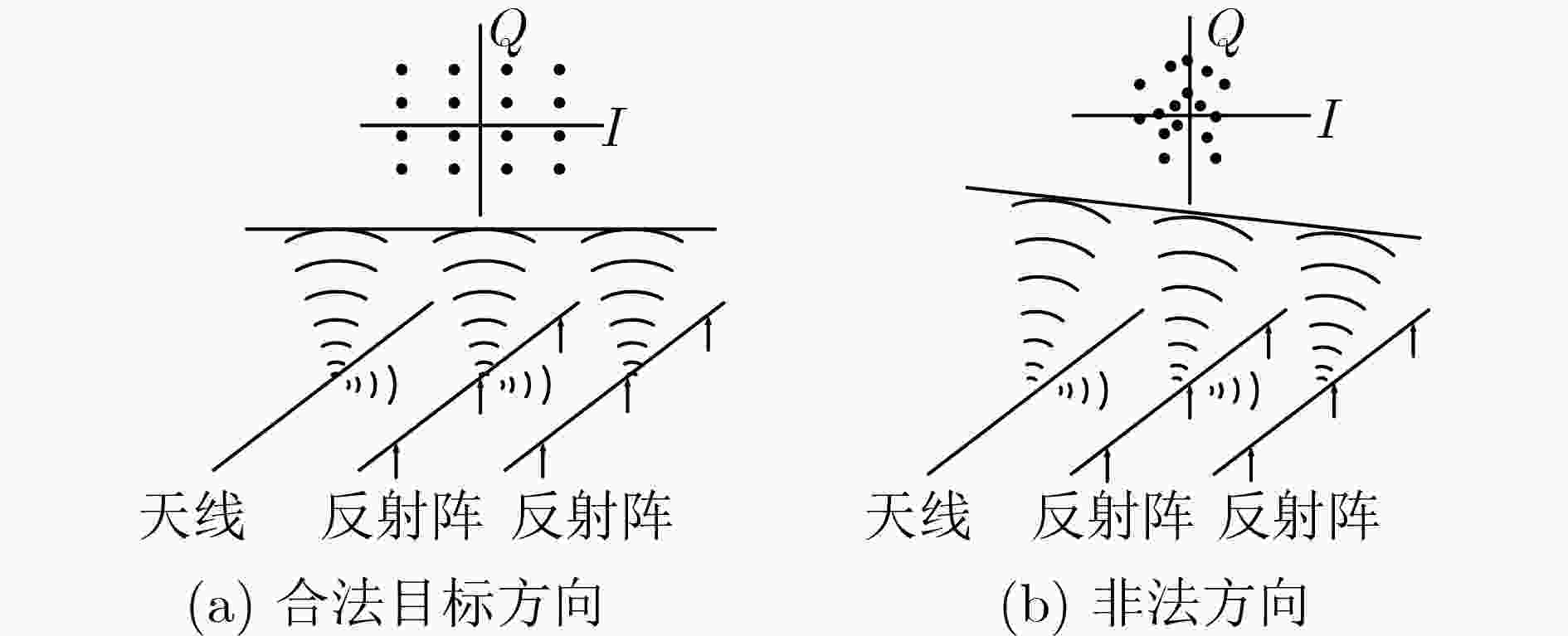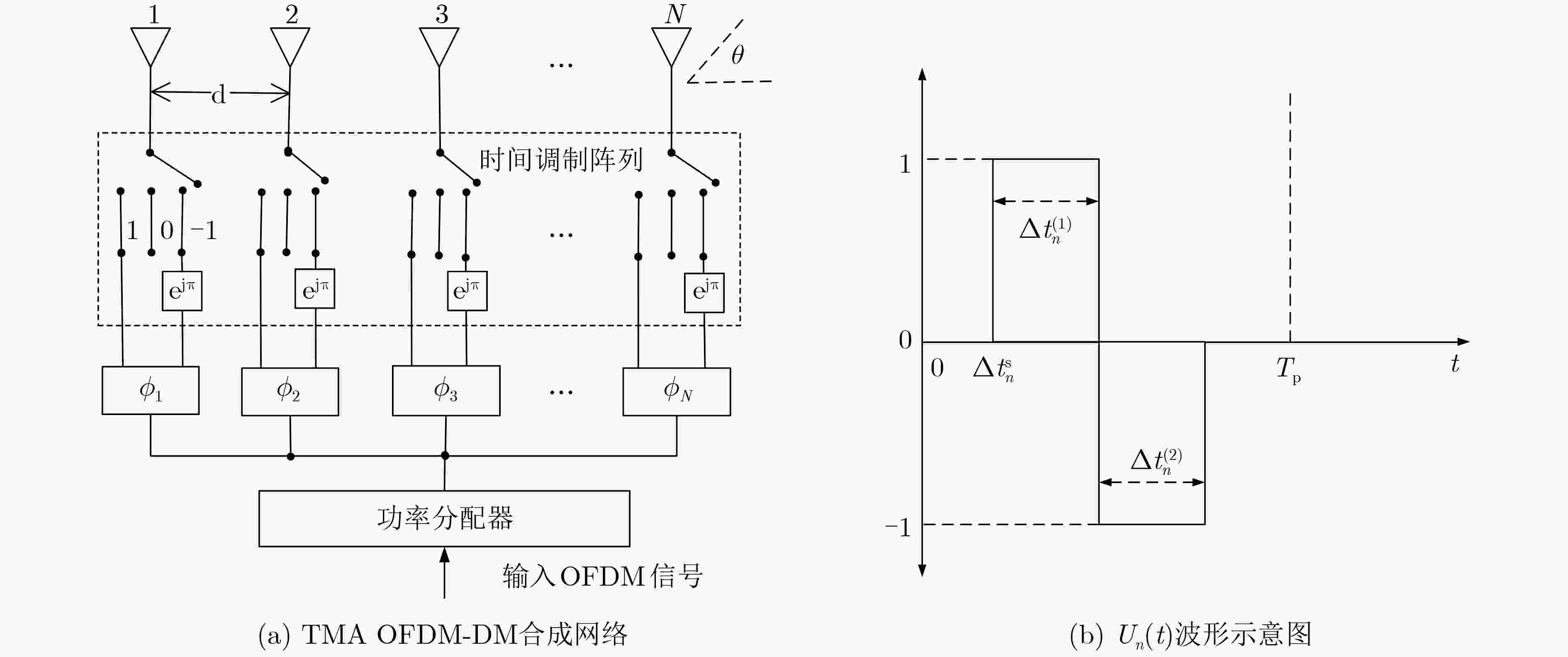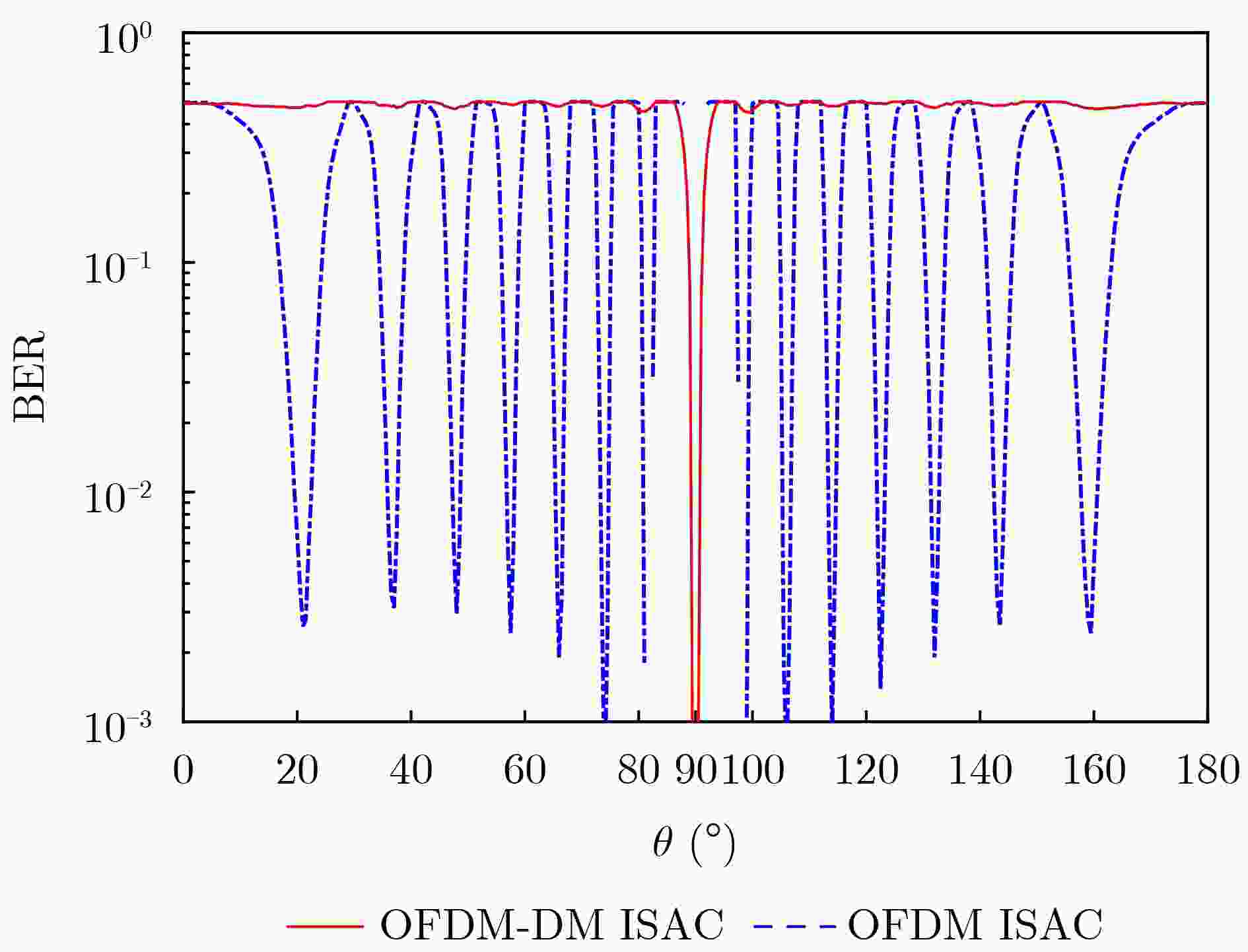Research on Directional Modulation Multi-carrier Waveform Design for Integrated Sensing and Communication
-
摘要: 通感一体化(ISAC)利用一种波形实现雷达感知与无线通信两种功能,能够消除雷达与通信电磁互扰,显著提高频谱效率、信息交互效率,已经成为6G潜在关键技术。目前,如何设计ISAC信号波形成为一体化设计广泛研究重点。方向调制(DM)一体化信号波形,因其独特的信号设计特点,能够在一体化信号设计种呈现出天然优势。该文从DM技术出发,介绍DM一体化波形设计理论、优势及挑战,并提出多载波DM一体化信号波形旁瓣干扰抑制机理,分析DM一体化波形参数对安全通信及雷达感知性能影响,为一体化波形在复杂环境中的安全、抗干扰需求设计提供新思路。Abstract:
Objective With the concurrent evolution of wireless communication and radar technologies, spectrum congestion has become increasingly severe. Integrated Sensing and Communication (ISAC) has emerged as an effective approach that unifies sensing and communication functionalities to achieve efficient spectrum and hardware sharing. Orthogonal Frequency Division Multiplexing (OFDM) signals are regarded as a key candidate waveform due to their high flexibility. However, estimating target azimuth angles and suppressing interference from non-target directions remain computationally demanding, and confidential information transmitted in these directions is vulnerable to eavesdropping. To address these challenges, the combination of Directional Modulation (DM) and OFDM, termed OFDM-DM, provides a promising solution. This approach enables secure communication toward the desired direction, suppresses interference in other directions, and reduces radar signal processing complexity. The potential of OFDM-DM for interference suppression and secure waveform design is investigated in this study. Methods As a physical-layer security technique, DM is used to preserve signal integrity in the intended direction while deliberately distorting signals in other directions. Based on this principle, an OFDM-DM ISAC waveform is developed to enable secure communication toward the target direction while simultaneously estimating distance, velocity, and azimuth angle. The proposed waveform has two main advantages: the Bit Error Rate (BER) at the radar receiver is employed for simple and adjustable azimuth estimation, and interference from non-target directions is suppressed without additional computational cost. The waveform maintains the OFDM constellation in the target direction while distorting constellation points elsewhere, which reduces correlation with the original signal and enhances target detection through time-domain correlation. Moreover, because element-wise complex division in the Two-Dimensional Fast Fourier Transform (2-D FFT) depends on signal integrity, phase distortion in signals from non-target directions disrupts phase relationships and further diminishes the positional information of interference sources. Results and Discussions In the OFDM-DM ISAC system, the transmitted signal retains its communication structure within the target beam, whereas constellation distortion occurs in other directions. Therefore, the BER at the radar receiver exhibits a pronounced main lobe in the target direction, enabling accurate azimuth estimation ( Fig. 5 ). In the time-domain correlation algorithm, the target distance is precisely determined, while correlation in non-target directions deteriorates markedly due to DM, thereby achieving effective interference suppression (Fig. 6 ). Additionally, during 2-D FFT processing, signal distortion disrupts the linear phase relationship among modulation symbols in non-target directions, causing conventional two-dimensional spectral estimation to fail and further suppressing positional information of interference sources (Fig. 7 ). Additional simulations yield one-dimensional range and velocity profiles (Fig. 8 ). The results demonstrate that the OFDM-DM ISAC waveform provides structural flexibility, physical-layer security, and low computational complexity, making it particularly suitable for environments requiring high security or operating under strong interference conditions.Conclusions This study proposes an OFDM-DM ISAC waveform and systematically analyzes its advantages in both sensing and communication. The proposed waveform inherently suppresses interference from non-target directions, eliminating target ambiguity commonly encountered in traditional ISAC systems and thereby enhancing sensing accuracy. Owing to the spatial selectivity of DM, only legitimate directions can correctly demodulate information, whereas unintended directions fail to recover valid data, achieving intrinsic physical-layer security. Compared with existing methods, the proposed waveform simultaneously attains secure communication and interference suppression without additional computational burden, offering a lightweight and high-performance solution suitable for resource-constrained platforms. Therefore, the OFDM-DM ISAC waveform enables high-precision sensing while maintaining communication security and hardware feasibility, providing new insights for multi-carrier ISAC waveform design. -
图 1 近场直接天线调制信号星座示意图[30]
表 1 ISAC波形设计方法的分类与比较
一体化波形分类 典型波形 优点 缺点 基于雷达信号 LFM 波形恒模、大带宽 通信数据速率低 基于通信信号 扩频 发射功率容忍度高、多址通信 测速计算量大 OFDM 抗多径干扰能力强、频谱利用率高、易于实现 高速场景下多普勒容忍差 OTFS 适用于高速场景 复杂度高 基于雷达-通信联合设计 设计新型波形 雷达和通信性能折中 复杂度高,硬件实现复杂 -
[1] LU Shihang, LIU Fan, LI Yunxin, et al. Integrated sensing and communications: Recent advances and ten open challenges[J]. IEEE Internet of Things Journal, 2024, 11(11): 19094–19120. doi: 10.1109/JIOT.2024.3361173. [2] 林粤伟, 张奇勋, 尉志青, 等. 通信感知一体化硬件设计——现状与展望[J]. 电子与信息学报, 2025, 47(1): 1–21. doi: 10.11999/JEIT240012.LIN Yuewei, ZAHNG Qixun, WEI Zhiqing, et al. Status and prospect of hardware design on integrated sensing and communication[J]. Journal of Electronics & Information Technology, 2025, 47(1): 1–21. doi: 10.11999/JEIT240012. [3] ROBERTON M and BROWN E R. Integrated radar and communications based on chirped spread-spectrum techniques[C]. IEEE MTT-S International Microwave Symposium Digest, Philadelphia, USA, 2003: 611–614. doi: 10.1109/MWSYM.2003.1211013. [4] CHEN Xiaobo, WANG Xiaomo, ZHANG Zhao, et al. A communication with LFM carrier modulated by MSK scheme[C]. IEEE ICCP2012, Nanjing, China, 2012: 461–463. (查阅网上资料, 未找到本条文献信息, 请确认). [5] LIU Zhipeng, CHEN Xiaobo, WANG Xiaomo, et al. Communication analysis of integrated waveform based on LFM and MSK[C]. IET International Radar Conference 2015, Hangzhou, China, 2015: 1–5. doi: 10.1049/cp.2015.1017. [6] 李晓柏, 杨瑞娟, 陈新永, 等. 基于分数阶傅里叶变换的雷达通信一体化信号共享研究[J]. 信号处理, 2012, 28(4): 487–494. doi: 10.3969/j.issn.1003-0530.2012.04.004.LI Xiaobai, YANG Ruijuan, CHEN Xinyong, et al. The sharing signal for integrated radar and communication based on FRFT[J]. Journal of Signal Processing, 2012, 28(4): 487–494. doi: 10.3969/j.issn.1003-0530.2012.04.004. [7] FAGHIH-NAINI S, SCHNEIDER M, PETERS S, et al. Combining an FMCW radar system with FSK modulation to a joint communication and sensing system[J]. International Journal of Microwave and Wireless Technologies, 2025, 17(2): 381–388. doi: 10.1017/S1759078725000121. [8] CAO Yu and YU Qiyue. A dual mode multi-beam and integrated CPM-LFM signal for dual-functional radar communication systems[J]. IEEE Transactions on Vehicular Technology, 2024, 73(10): 15270–15285. doi: 10.1109/TVT.2024.3412711. [9] MA Dingyou, SHLEZINGER N, HUANG Tianyao, et al. FRaC: FMCW-based joint radar-communications system via index modulation[J]. IEEE Journal of Selected Topics in Signal Processing, 2021, 15(6): 1348–1364. doi: 10.1109/JSTSP.2021.3118219. [10] MIZUI K, UCHIDA M, and NAKAGAWA M. Vehicle-to-vehicle communication and ranging system using spread spectrum technique (Proposal of Boomerang Transmission System)[C]. IEEE 43rd Vehicular Technology Conference, Secaucus, USA, 1993: 335–338. doi: 10.1109/VETEC.1993.507206. [11] UCHIDA M, KAGAWA Y, and OKUNO A. A vehicle-to-vehicle communication and ranging system based on spread spectrum technique-SS communication radar[C]. VNIS'94 - 1994 Vehicle Navigation and Information Systems Conference, Yokohama, Japan, 1994: 169–174. doi: 10.1109/VNIS.1994.396845. [12] XU Shaojian, CHEN Bing, and ZHANG Ping. Radar-communication integration based on DSSS techniques[C]. 2006 8th International Conference on Signal Processing, Guilin, China, 2006: 16–20. doi: 10.1109/ICOSP.2006.346041. [13] JAMIL M, ZEPERNICK H, and PETTERSSON M. On integrated radar and communication systems using Oppermann sequences[C]. MILCOM 2008-2008 IEEE Military Communications Conference, San Diego, USA, 2008: 1–6. doi: 10.1109/MILCOM.2008.4753277. [14] 赵羚岚, 杨奕冉, 刘喜庆, 等. 基于完全互补码扩频的通信雷达一体化系统[J]. 无线电通信技术, 2023, 49(1): 118–125. doi: 10.3969/j.issn.1003-3114.2023.01.014.ZHAO Linglan, YANG Yiran, LIU Xiqing, et al. Integrated communication and radar system based on complete complementary code spread spectrum[J]. Radio Communications Technology, 2023, 49(1): 118–125. doi: 10.3969/j.issn.1003-3114.2023.01.014. [15] 叶子豪, 鄢社锋, 杨斌斌. 基于子载波间干扰深度估计的MIMO-OFDM水声通信接收机[J]. 电子与信息学报, 2023, 45(7): 2519–2527. doi: 10.11999/JEIT220794.YE Zihao, YAN Shefeng, and YANG Binbin. MIMO-OFDM underwater acoustic communication receiver based on intercarrier interference depth estimation[J]. Journal of Electronics & Information Technology, 2023, 45(7): 2519–2527. doi: 10.11999/JEIT220794. [16] LEVANON N. Multifrequency complementary phase-coded radar signal[J]. IEE Proceedings - Radar, Sonar and Navigation, 2000, 147(6): 276–284. doi: 10.1049/ip-rsn:20000734. [17] STURM C and WIESBECK W. Waveform design and signal processing aspects for fusion of wireless communications and radar sensing[J]. Proceedings of the IEEE, 2011, 99(7): 1236–1259. doi: 10.1109/JPROC.2011.2131110. [18] 韩潇弘毅, 鲍蕾蕾, 杨瑞娟, 等. 基于OFDM雷达通信共享信号性能分析[J]. 空军预警学院学报, 2013, 27(4): 270–274. doi: 10.3969/j.issn.2095-5839.2013.04.011.HAN Xiaohongyi, BAO Leilei, YANG Ruijuan, et al. Performance analysis of radar and communication signals sharing based on OFDM[J] Journal of Air Force Early Warning Academy, 2013, 27(4): 270–274. doi: 10.3969/j.issn.2095-5839.2013.04.011. [19] 刘永军, 廖桂生, 杨志伟. 基于OFDM的雷达通信一体化波形模糊函数分析[J]. 系统工程与电子技术, 2016, 38(9): 2008–2018. doi: 10.3969/j.issn.1001-506X.2016.09.07.LIU Yongjun, LIAO Guisheng, and YANG Zhiwei. Ambiguity function analysis of integrated radar and communication waveform based on OFDM[J]. Systems Engineering and Electronics, 2016, 38(9): 2008–2018. doi: 10.3969/j.issn.1001-506X.2016.09.07. [20] HUANG Gaojian, DING Yuan, OUYANG Shan, et al. Index modulation for OFDM RadCom systems[J]. The Journal of Engineering, 2021, 2021(2): 61–72. doi: 10.1049/tje2.12003. [21] HADANI R, RAKIB S, TSATSANIS M, et al. Orthogonal time frequency space modulation[C]. 2017 IEEE Wireless Communications and Networking Conference (WCNC), San Francisco, USA, 2017: 1–6. doi: 10.1109/WCNC.2017.7925924. [22] YUAN Weijie, ZHOU Lin, DEHKORDI S K, et al. From OTFS to DD-ISAC: Integrating sensing and communications in the delay Doppler domain[J]. IEEE Wireless Communications, 2024, 31(6): 152–160. doi: 10.1109/MWC.018.2300607. [23] WEI Xinyuan, YUAN Weijie, ZHANG Kecheng, et al. OTFS-assisted ISAC system: Delay Doppler channel estimation and SDR-based implementation[J]. IEEE Transactions on Mobile Computing, 2025, 24(11): 11865–11878. doi: 10.1109/TMC.2025.3582421. [24] LIU Fan, ZHOU Longfei, MASOUROS C, et al. Toward dual-functional radar-communication systems: Optimal waveform design[J]. IEEE Transactions on Signal Processing, 2018, 66(16): 4264–4279. doi: 10.1109/TSP.2018.2847648. [25] LIU Xiang, HUANG Tianyao, SHLEZINGER N, et al. Joint transmit beamforming for multiuser MIMO communications and MIMO radar[J]. IEEE Transactions on Signal Processing, 2020, 68: 3929–3944. doi: 10.1109/TSP.2020.3004739. [26] WANG Jionghui, WANG Bin, FANG Jun, et al. Low-complexity joint communication and sensing beamforming for ISAC systems: A bisection search approach[J]. IEEE Internet of Things Journal, 2025, 12(13): 25620–25632. doi: 10.1109/JIOT.2025.3558954. [27] HUANG Gaojian, DING Yuan, OUYANG Shan, et al. Target localization using time-modulated directional modulated transmitters[J]. IEEE Sensors Journal, 2022, 22(13): 13508–13518. doi: 10.1109/JSEN.2022.3178699. [28] HUANG Gaojian, ZHANG Kailuo, ZHANG Yanliang, et al. Orthogonal frequency division multiplexing directional modulation waveform design for integrated sensing and communication systems[J]. IEEE Internet of Things Journal, 2024, 11(18): 29588–29599. doi: 10.1109/JIOT.2024.3367490. [29] DING Yuan and FUSCO V F. A vector approach for the analysis and synthesis of directional modulation transmitters[J]. IEEE Transactions on Antennas and Propagation, 2014, 62(1): 361–370. doi: 10.1109/TAP.2013.2287001. [30] BABAKHANI A, RUTLEDGE D, and HAJIMIRI A. Transmitter architectures based on near-field direct antenna modulation[J]. IEEE Journal of Solid-State Circuits, 2008, 43(12): 2674–2692. doi: 10.1109/JSSC.2008.2004864. [31] DALY M P and BERNHARD J T. Directional modulation technique for phased arrays[J]. IEEE Transactions on Antennas and Propagation, 2009, 57(9): 2633–2640. doi: 10.1109/TAP.2009.2027047. [32] DING Yuan and FUSCO V. A synthesis-free directional modulation transmitter using retrodirective array[J]. IEEE Journal of Selected Topics in Signal Processing, 2017, 11(2): 428–441. doi: 10.1109/JSTSP.2016.2605066. [33] DING Yuan, ZHANG Yunhua, and FUSCO Vincent. Fourier Rotman lens enabled directional modulation transmitter[J]. International Journal of Antennas and Propagation, 2015, 2015: 285986. doi: 10.1155/2015/285986. [34] HUANG Gaojian, DING Yuan, OUYANG Shan, et al. Three-state time modulated array-enabled directional modulation for secure orthogonal frequency-division multiplexing wireless transmission[J]. IET Communications, 2022, 16(19): 2321–2327. doi: 10.1049/cmu2.12485. -






 下载:
下载:









 下载:
下载:
